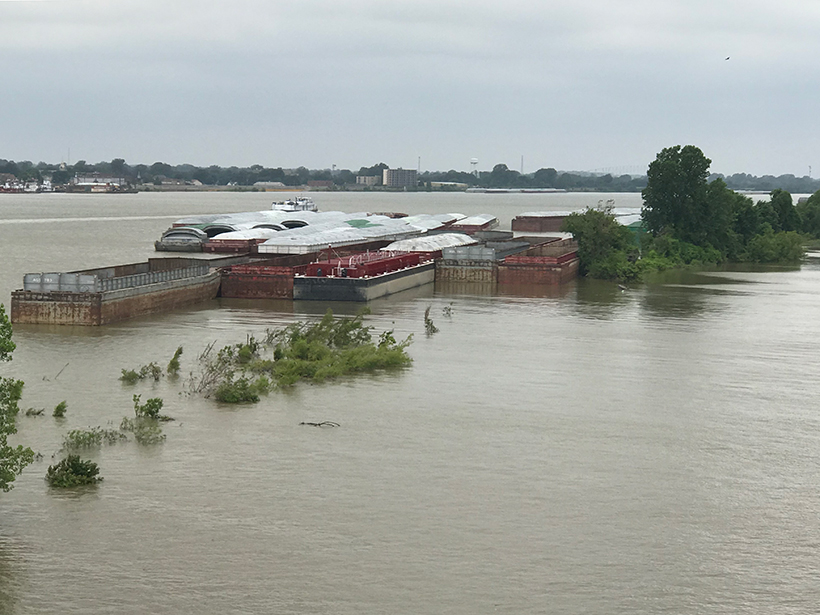Stakeholders in industry, agriculture, and city governments are struggling to understand how to manage climate change risks. Climate scientists, meanwhile, want to know what specific information their fellow citizens need from them to take action.
Last July, Argonne National Laboratory in Lemont, Ill., brought a group of 20 representatives from energy industries, agriculture, and city governments together with 15 climate change and risk researchers from across the U.S. Midwest to discuss how best to assess climate risks to infrastructure in the region. The workshop addressed four goals:
- understanding the specific practical climate change challenges that energy industries, agriculture, and cities face
- identifying informational needs and gaps that prevent development of effective approaches to manage climate change risk
- exploring the specific research and data needed to fill information gaps
- building relationships and learning from each other to pave the way to effective resiliency and risk management plans
A Growing List of Concerns
Rao Kotamarthi of Argonne National Lab opened the workshop by addressing current global-to-local climate projections. Participants then discussed their greatest concerns, each through their own lens of professional experience, specifically focusing on climate hazards in the Midwest: drought, precipitation changes, heat and heat waves, flooding, and extreme wind and tornadoes. They voiced concerns over how to identify who should decide the best regional response as well as about the impact of heavier rainfall events on treating storm water and wastewater, among many other topics.
As the group discussed specific hazards in more detail, the list of concerns grew to several hundred. Although climate projections predict that precipitation will increase in the Midwest, the group also considered drought because of its crosscutting impacts on barge transportation, nuclear reactor cooling, agriculture, and potable water. Participants also recognized that rather than relying only on rainfall averages, it is also important to consider precipitation duration, intensity, frequency, and type (rain, hail, sleet, snow).
Building Resilience
Just as biodiversity enhances ecosystem resilience, diverse teams with differing perspectives will create the most effective solutions for dealing with climate change.
Following the discussion of participants’ concerns, Cameron Davis, an elected commissioner of the Metropolitan Water Reclamation District of Greater Chicago, discussed resilient decision-making systems for tackling climate change risks. Citing the example of the successful Great Lakes Restoration Initiative established in 2010, he argued that just as biodiversity enhances ecosystem resilience, diverse teams with differing perspectives will create the most effective solutions for dealing with climate change.
The group discussed the information needed for effective climate change planning through role-playing scenarios. For example, they explored the roles of an administrator of a big midwestern city facing increased flooding and precipitation and that of a utility provider facing steadily increasing temperatures. Participants identified possible hazards and their impacts on cities or utilities under these climate change scenarios, as well as actions that could be taken now to address the impacts and actions that would require new institutional systems, processes, or practices.
To site and protect communications infrastructure, very high resolution flood maps based on future climate are needed.
As a case study, Antoine Diffloth, director of Data Insights at AT&T, discussed his company’s efforts in collaboration with Argonne to assess AT&T’s climate resilience. He argued that storm damage to long-lived communication infrastructure was a major risk. To site and protect such infrastructure, very high resolution flood maps based on future climate are needed. His talk spurred the workshop group to identify data and research needs for improving the climate resiliency of midwestern energy industries, agriculture, and cities. Such data and research could include real-time monitoring of aquifer drawdown and better understanding of the probabilities of future extreme events such as ice storms, high winds, and drought, as well as floods.
As the workshop concluded, researchers and practitioners agreed that both groups benefited by gathering to learn each other’s perspectives and concerns. Argonne is preparing a workshop report that will be accessible through Argonne’s Climate Risk and Resiliency Studies web page.
Author Information
Robin Graham ([email protected]), Computing, Environment and Life Sciences Directorate, Argonne National Laboratory (ANL), Lemont, Ill.; Cristina Negri, Environmental Science Division, ANL, Lemont, Ill.; Thomas Wall, Decision and Infrastructure Sciences Division, ANL, Lemont, Ill.; and V. Rao Kotamarthi, Environmental Science Division, ANL, Lemont, Ill.
Citation:
Graham, R.,Negri, C.,Wall, T., and Kotamarthi, V. R. (2019), Working together to close climate change information gaps, Eos, 100, https://doi.org/10.1029/2019EO137850. Published on 16 December 2019.
Text not subject to copyright.
Except where otherwise noted, images are subject to copyright. Any reuse without express permission from the copyright owner is prohibited.

